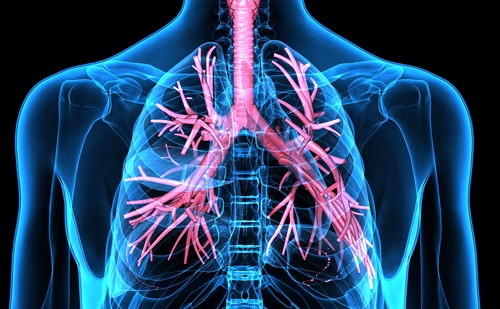Bronchiectasis is a chronic pulmonary disorder characterized by permanent bronchial dilatation, which in some children may be reversible, and airway inflammation, and by cough and sputum production, as well as recurrent respiratory tract infections.1 Bronchiectasis is associated with poor quality of life for the child/adolescent and their parents, recurrent exacerbations and high cost to healthcare systems.2
Recently, the European Respiratory Society (ERS) Task Force for the management of paediatric bronchiectasis produced guidelines for the management of children and adolescents with bronchiectasis.3 In an expert interview, Professor Bush discusses the key recommendations in the guidelines.
Q. Why is there a need for new guidelines for the management of bronchiectasis?
Bronchiectasis is an orphan disease and is often neglected. In one study of bronchiectasis in adults, symptoms in nearly half of the patients had started in childhood, but no one had paid any attention to them.4 The symptoms of chronic productive cough are often not taken seriously in children. Key participants of our bronchiectasis guidelines group were parents from the European Lung Foundation. They emphasized how frustrating they found multiple trips to doctors and healthcare professionals saying that something was wrong with their child, but nothing was being done; the diagnostic journey took a very long time indeed.
There is also a need for an effective management pathway for these children because appropriate therapy can stabilize the condition, reverse changes seen on computed tomography scans in some cases, and prevent deterioration. If you ignore the problem, however, the child will develop impaired lung function, experience exacerbations of bronchiectasis and have a much worse quality of life. The purpose of the guidelines was to draw together all the available evidence and make recommendations to improve the management of children with bronchiectasis.
Q. What evidence supports the use of anti-inflammatory therapies in bronchiectasis?
The main thrust of treatment is antibiotics for infection. Inflammation also occurs in the airways of people with bronchiectasis. However, it is important to distinguish between inflammation that is beneficial in clearing the airways of infection, and excessive exuberant inflammation that may damage the tissues. In cystic fibrosis, a related condition, there is evidence that damping down the inflammation may be beneficial. There is no such evidence in bronchiectasis. However, an excellent Australasian study showed that regular treatment with azithromycin, an antibiotic with a number of anti-inflammatory effects, reduced the number of acute bronchiectasis exacerbations, improving quality of life.5 We do not know whether the effect of azithromycin was related to its antibacterial or its anti-inflammatory properties. Furthermore, the risk of acquiring resistance to azithromycin is always present if it is used excessively.
Other anti-inflammatory drugs prescribed for these patients include inhaled corticosteroids, which are often started following a misdiagnosis of asthma. Inhaled corticosteroids are an effective treatment for school age asthma; however, unless the patient also has eosinophilic allergic asthma, they should not be given for bronchiectasis. In fact, corticosteroids pose some risk, as they damp down the protective inflammatory response in the airways, increasing the susceptibility to infection.
Q. In whom is long-term bronchodilator therapy recommended?
It is important to check that the patient responds to bronchodilators before using them long-term. This can be done easily in older children, who can measure their lung function before and after bronchodilator use. A few patients respond, in which case they should use them. However, many do not respond, and some case reports have described paradoxical bronchoconstriction with the use of bronchodilators, so it is essential to measure their effects if they are to be used.6,7
Q. In whom should long-term antibiotics be considered?
Currently, we do not have sufficient data to answer this question. The azithromycin study described above was conducted over many months and is the only study we have about the duration of antibiotic therapy in children. There is a great need for further research in bronchiectasis, and one of the purposes of the ERS guidelines is to highlight this need. A bronchiectasis clinical research network, of which I am a member, called the Children’s Bronchiectasis Education Advocacy and Research Network (BEAR-net), funded by the ERS, also aims to push forward a research agenda. Currently, we do not know who should receive long-term antibiotics or which antibiotics should be used. We have to make decisions based on very poor-quality evidence. Most of us would prescribe long-term nebulized antibiotics to a patient chronically infected with Pseudomonas aeruginosa. Such a strategy is beneficial in patients with cystic fibrosis, but we simply do not know if this is also the case in patients with bronchiectasis.
Q. What non-pharmacological interventions improve outcomes for patients with bronchiectasis?
This is a very important question. Basic respiratory care is essential. This means avoidance of tobacco and e-cigarettes (active and passive exposure), exercise, airway clearance, making sure immunizations are given, good nutrition and a healthy lifestyle. Chest physiotherapy is extremely important. A skilled respiratory physiotherapist will help the child with exercises to keep the lungs clear. The nature of these exercises will change as the young person gets older. The involvement of a skilled respiratory physiotherapist is crucial if bronchiectasis is to be managed properly. These basic tenets are essential and must be adhered to. A multidisciplinary approach should be taken.
Q. What is the key message from these guidelines that you wish to impart?
The key message is to consider a diagnosis of bronchiectasis in a child with a chronic wet cough of more than 4–8 weeks’ duration. Every child coughs when they have a cold, but there is a crucial distinction between a child with a cold and a wet cough for 2–3 weeks who then recovers completely, and a child with a persistent wet cough for 4–8 weeks. That child needs investigating. There is probably an underlying cause, and whether or not the cause is found, effective measures to prevent progression of lung damage are absolutely essential.






